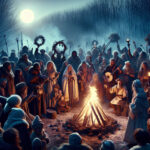This article will explore the fascinating and complex mythology of the Pagan Goddess. This goddess has been revered by many cultures throughout the ages and has come to be seen as a symbol of strength, wisdom, and fertility. We will take a look at her history and symbolism, as well as her role in modern Paganism. We will also discuss how she is viewed in different cultures and how she can be honored in various ways. This article aims to provide an overview of the Pagan Goddess and her place in the world today.
The pagan goddess has long been a source of fascination and mystery throughout history. In many cultures, she has been seen as a powerful and influential figure, with a variety of roles and powers. She is often associated with fertility, love, and the protection of the Earth. In this article, we will explore the history and symbolism of the pagan goddess and discuss her importance in modern paganism.
What is a Pagan Goddess?
A pagan goddess is a female deity or spirit from a polytheistic religion. Unlike monotheistic religions, which worship one god, pagan religions often worship multiple gods and goddesses. Pagan goddesses are typically associated with different natural elements, such as the moon, the sun, or the Earth. They are often seen as powerful figures, with the ability to help or harm humans. In some cultures, the goddess is seen as being in charge of the cycles of life and death, as well as being responsible for fertility.
History of the Pagan Goddess
The history of the pagan goddess is long and varied. She can be found in many ancient cultures, such as the Egyptians, the Greeks, and the Romans. In some cases, the goddess was seen as a single figure, while in others, she was seen as a group of multiple goddesses. For example, the ancient Egyptians worshiped a group of goddesses known as the “Nine Goddesses”.
The pagan goddess was also an important figure in the Celtic and Norse cultures. In the Celtic tradition, the goddess was often seen as a powerful figure, associated with both fertility and death. In the Norse tradition, she was known as the “All-Mother”, and was seen as the source of all life and death. In both cultures, she was seen as a source of wisdom and guidance.
Symbolism of the Pagan Goddess
The pagan goddess is often associated with a variety of symbols. In many cultures, she is seen as a mother figure, and is often associated with the moon and the earth. She is also often associated with fertility, love, and protection. In some cultures, she is seen as a goddess of death, with the power to grant life or take it away.
The goddess is often depicted in artwork and sculptures, with a variety of symbols and shapes. In some cultures, she is seen as a powerful warrior, while in others she is seen as a nurturing mother. Additionally, she is often associated with animals, such as the lion, the wolf, and the snake.
Importance of the Pagan Goddess in Modern Paganism
The pagan goddess is an important figure in modern paganism. Many pagans believe that she is the source of all life and death, and the protector of the Earth. Additionally, many pagans view her as a powerful source of wisdom and guidance. In some traditions, she is seen as a symbol of fertility and love, while in others she is seen as a powerful warrior.
The goddess is often invoked in rituals and ceremonies, and her symbols are often used as talismans. Additionally, many pagans pray to her for protection and guidance. Many pagans also celebrate holidays and festivals in her honor, such as the Spring Equinox and Beltane.
Conclusion
The pagan goddess has long been a source of fascination and mystery throughout history. She is often seen as a powerful and influential figure, with a variety of roles and powers. In many cultures, she is seen as a mother figure, associated with fertility, love, and the protection of the Earth. She is also often invoked in rituals and ceremonies and her symbols are used as talismans.
The pagan goddess is an important figure in modern paganism, and many pagans view her as a powerful source of wisdom and guidance. Additionally, many pagans celebrate holidays and festivals in her honor. Ultimately, the pagan goddess is a complex and mysterious figure, and her importance in modern paganism cannot be overstated.
In conclusion, it is clear that the Pagan Goddess is an important figure within the Pagan religion and culture. She is seen as a symbol of fertility, abundance, and femininity, and is often venerated in various religious rituals. Her presence is a reminder of the importance of honoring the divine feminine, and her power is a source of strength and inspiration. As we continue to explore the mysteries of the divine, it is important to remember the Pagan Goddess and her place in history and culture. By honoring her, we are honoring the divine feminine, and strengthening our connection to the divine.





